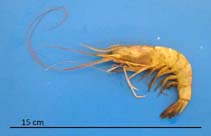Xiphopenaeus kroyeri (Heller, 1862)
Atlantic seabob| Native range | All suitable habitat | Point map | Year 2050 |

|
| This map was computer-generated and has not yet been reviewed. |
| Xiphopenaeus kroyeri AquaMaps Data sources: GBIF OBIS |
Classification / Names आम नाम | उपशब्द | CoL | ITIS | WoRMS
Malacostraca | Decapoda | Penaeidae
Environment: milieu / climate zone / गहराई सीमा / distribution range पारिस्थितिकी
; खारा; गहराई सीमा 0 - 70 m (संदर्भ 8), usually ? - 27 m (संदर्भ 8). Tropical; 17°C - 26°C (संदर्भ 132369), preferred 26°C (संदर्भ 107945); 36°N - 32°S, 109°W - 34°W
Distribution देश | ऐफ ऐ ओ क्षेत्र | Ecosystems | संयोग | भूमिका
Eastern Central Pacific, Western Atlantic and the Arctic: North Carolina to Gulf of Mexico, Caribbean to Brazil (Ref. 91956), and Mexico to Peru (Ref. 94212), Pacific South America. Tropical to polar.
Length at first maturity / आकार / Weight / Age
परिपक्व अवधि: Lm 1.4, range 1 - 1.75 cm Max length : 17.0 cm TL पुल्लिंग / अलिंग; (संदर्भ 8)
Life cycle and mating behavior परिपक्व अवधि | पुनरुत्पत्ति | मछलीऔ का अंडे देना | Eggs | Fecundity | Larvae
Main reference
संदर्भ | संयोजक | सहयोगीयो
Holthuis, L.B. 1980 FAO Species Catalogue. Vol. 1. Shrimps and prawns of the world. An annotated catalogue of species of interest to fisheries. FAO Fish. Synop. 125(1):271 p. Rome: FAO. (संदर्भ 8)
IUCN Red List Status
(संदर्भ 130435: Version 2025-1)
CITES status (संदर्भ 108899)
CMS (संदर्भ 116361)
Threat to humans
Human uses
मात्स्यिकी: व्यापारिक
FAO - मात्स्यिकी: landings, species profile | FIRMS (Stock assessments) | FishSource | Sea Around Us
साधन
अधिक जानकारी
इंटरनेट स्रोत
BHL | BOLD Systems | CISTI | DiscoverLife | FAO(मात्स्यिकी: species profile; publication : search) | Fishipedia | GenBank (genome, nucleotide) | GloBI | Gomexsi | Google Books | Google Scholar | Google | PubMed | Tree of Life | Wikipedia (Go, खोज) | Zoological Record



